The Leibniz-IZW is an internationally renowned German research institute. It is part of the Forschungsverbund Berlin e.V. and a member of the Leibniz Association. Our goal is to understand the adaptability of wildlife in the context of global change and to contribute to the enhancement of the survival of viable wildlife populations. For this purpose, we investigate the diversity of life histories, the mechanisms of evolutionary adaptations and their limits, including diseases, as well as the interrelations of wildlife with their environment and people. We use expertise from biology and veterinary medicine in an interdisciplinary approach to conduct fundamental and applied research – from the molecular to the landscape level – in close dialogue with the public and stakeholders. Additionally, we are committed to unique and high-quality services for the scientific community.
+++ Current information on African swine fever: The Leibniz-IZW conducts research on the population dynamics, on models of disease outbreaks in wild boars and on the ecology and human-wildlife interaction in urban areas. African swine fever is a reportable disease in domestic swine and therefor is the purview of the respective federal state laboratories and the Friedrich-Loeffler-Institut (Federal Research Institute for Animal Health) FLI. +++
News
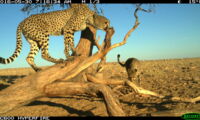
Territory holders and floaters: two spatial tactics of male cheetahs
Scientists of the Leibniz Institute for Zoo and Wildlife Research (Leibniz IZW) in Berlin analysed the spatial behaviour of cheetahs. They showed that male cheetahs operate two space use tactics which are associated with different life-history stages. This long-term study on movement data of over 160 free-ranging cheetahs in Namibia has now been published in the scientific journal ECOSPHERE.
Read more … Territory holders and floaters: two spatial tactics of male cheetahs
%20ralph%20frank%20wwf-6renkxhmqh1agpx.jpg)
Lynxes in danger
A new study suggests that humans are putting pressure on the population of these big cats in the Germany-Czech Republic-Austria border area.
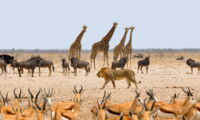
Dry landscapes can increase disease transmission
In water-limited landscapes sick animals can have increased contact with healthy individuals, which can facilitate disease transmission. Scientists from the German Leibniz Institute for Zoo and Wildlife Research (Leibniz-IZW) present these findings in the British Ecological Society journal Functional Ecology.
Read more … Dry landscapes can increase disease transmission
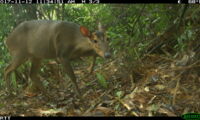
First record of large-antlered muntjac in Quang Nam, Vietnam, in the wild provides new hope for the survival of this species
Quang Nam – 21st May, 2018 - In November 2017 - under a biodiversity monitoring and assessment activity supported by the US Agency for International Development (USAID) - scientists and conservationists of the Leibniz Institute for Zoo and Wildlife Research (Leibniz-IZW) and WWF-Vietnam captured photographs of one of the rarest and most threatened mammal species of Southeast Asia, the large-antlered muntjac (Muntiacus vuquangensis), in Quang Nam province, central Vietnam. Prior to this milestone, this species had only been camera trapped in three protected areas in all of Vietnam since the year 2000. The new records from Quang Nam - which include photographs of both a male and a female - provide new hope for the continued survival of a species that is on the brink of extinction.

The dark side of our genes – healthy ageing in modern times
The transition to modernity – largely driven by the Industrial Revolution – provided us with easier access to food and clean water, with antibiotics, vaccines, and modern medicine. Yet modernity did not just bring fewer infectious diseases and longer life: it also created an environment radically different from the one we evolved in. Genes helpful in our evolutionary past may now predispose us to chronic disease – such as cardiovascular diseases and cancer – in old ages. In a paper published in the journal Nature Review Genetics an international team of five scientists collate the evidence for this mismatch between past evolutionary adaptation and our modern lives. They also ask whether natural selection linked to modernization might reduce globally the burden of some chronic diseases.
Read more … The dark side of our genes – healthy ageing in modern times
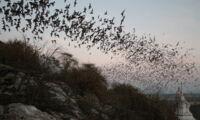
Above us only sky – the open air as an underappreciated habitat
Numerous bat species hunt and migrate at great altitudes. Yet the open sky had, until recently, not been on the radar of conservation scientists as a habitat relevant to a large variety of species. Christian Voigt and colleagues from the Leibniz Institute for Zoo and Wildlife Research (IZW) in Berlin have collated the current scientific knowledge on potential hazards to one group of animals flying at high altitudes, bats. In their recent article published in BioScience the authors synthesise threats facing bats in troposphere and provide recommendations for potential protective measures to ensure persistence of bats and other high-flying animals.
Read more … Above us only sky – the open air as an underappreciated habitat
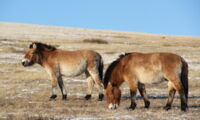
Przewalski’s Horse is a Feral Domestic Horse
Przewalski’s horses were thought to be the last wild species of horse. A recent international study led by Professor Ludovic Orlando, involving the Leibniz Institute for Zoo and Wildlife Research (IZW), has upended that theory. The study, published in the journal “Science“, changes our point of view about domestic horse origins. Based on their archaeological and genetic investigations, the researchers were able to prove that Przewalski’s horse is descended from once-domesticated stock. Some of the horses from the domesticated herds escaped and became the ancestors of all present-day Przewalski’s horse populations. A second horse species existing at that time replaced Przewalski’s horses as domestic horses, establishing the lineage from which all modern domestic horses descend.
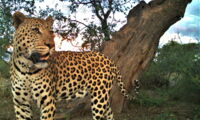
Leopard meals: females go for diversity
Female leopards have a much wider spectrum of prey species than males.




